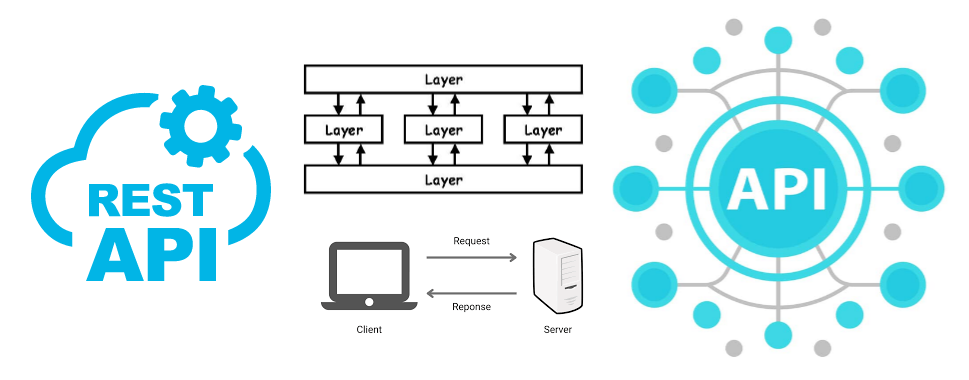Introduction
REST as defined in Roy T Fielding’s thesis defines six architectural constraints which make any web service – a truly RESTful API. These are also called as Fielding’s constraints. They generalize the Web’s architectural principles and represent them as a framework of constraints or an architectural style. The REST constraints are
- Client–server architecture.
- Stateless.
- Cacheable.
- Uniform interface.
- Layered system.
- Code on demand.
Implementing the above constraints has several advantages. It allows the service to use standard internet infrastructure elements such as caches, proxies and load balancers. This allows service developers to focus on core service logic rather than reinvent the wheel implementing custom caching services or security layers.
Client- Server Architecture
This constraint species that the client and server must be able to evolve independently. They must have no dependency of any sort on each other. The only information needed is for the client to know the resource URIs on the server. This encourages separation of concerns between the client and the server allowing them to evolve independently. The client is not concerned with data storage, which remains internal to the server, so that the portability of client code is improved. The server is not concerned with the user interface or user state, so that servers can be simpler and more scalable. It improves portability of the user interface across multiple platforms and improves scalability by simplifying the server components.
Stateless
A REST service must be stateless. Each request from the client to the server must contain all the information needed to understand and complete the request. The server should not need any additional information from previous requests to fulfill the current request. This shifts the responsibility of maintaining state to the client freeing the server to focus on fulfilling as many requests as possible. The necessary state to operate the request is contained within the request as a part of the URI, query-string parameters, body, or headers. A stateless service is easily scalable since additional servers can be added or removed as necessary without having to worry about routing subsequent requests to the same server. These can be further load balanced as necessary.
Cacheable
To improve network efficiency, responses must be defined as cacheable or non-cacheable. A REST service must explicitly indicate cacheblilty of responses. The service should also indicate the duration for which the cached response is valid. Caching helps improve performance on the client side and scalability on the server side. If the client has access to a valid cached response for a given request, it avoids repeating the same request. Instead, it uses its cached copy. Effective use of caching, partially or completely eliminates some client–server interactions, further improving scalability and performance.
Uniform Interface
This constraint is fundamental to the design of any RESTful system. The uniform interface defines a contract for communication between the client and the server. It simplifies and decouples the architecture, which enables each part to evolve independently. The four guiding principles of the uniform interface are
Resource-Based
As discussed in What is REST? resources are uniquely identified by URI’s. These identifiers are stable and do not change across interactions even when the resource state changes.
Manipulation of resources through representations
When a client holds a representation of a resource, it has enough information to modify or delete the resource. A client manipulates resources by sending new representations of the resource to the service. The server controls the resource representation and can accept or reject the new resource representation sent by the client.
Self-descriptive messages
REST request and response messages contain all information needed for the service and the client to interpret the message and handle it appropriately. The messages are quite verbose and include the method, protocol used and the content type. This enables each message to be independent.
Hypermedia as the Engine of Application State (HATEOAS)
Hypermedia connects resources to each other and describes their capabilities in machine-readable ways. Hypermedia is a strategy, implemented in different ways by dozens of technologies. Hypermedia is a way for the server to tell the client what HTTP requests the client might want to make in the future. This is a key part of what makes an API RESTful. This blog post describes HATEOAS in more detail.
Layered System
A layered system further builds on the concept of client-server architecture. A layered system indicates that there can be more components than just the client and the server and each system can have additional layers in it. Intermediary layers can improve system scalability by enabling load balancing and by providing shared caches. They can also enforce security policies. These layers should be easy to add, remove or change. Proxies, gateways, load balancer’s are examples of intermediate layers.
Code on Demand
Code on Demand is an optional constraint. Code on Demand allows flexibility to the client by allowing it to download code. Servers are able to temporarily extend or customize the functionality of a client by transferring logic to it that it can execute. This enables transferring additional logic to the client to be executed. This is primarily accomplished using JavaScript, applets and other web technologies.
These constraints describe what a truly RESTful API should look like. By adhering to these constraints, a RESTful system aims to achieve performance, scalability, simplicity, modifiability, visibility, portability, and reliability. The Richardson’s Maturity Model provides a guided journey on creating REST based services in an incremental manner and is a good process to use when building REST based architectures.
